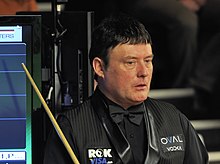Tenball
| Tournament information | |
|---|---|
| Dates | 8 April–20 May 1995 |
| Venue | Methodist Church Hall[1] |
| City | London |
| Country | United Kingdom |
| Organisation(s) | ITV, LWT |
| Winner's share | £20,000 |
| Final | |
| Champion | |
| Runner-up | |
| Score | 3–1 |
Tenball was a cue sports tournament that was staged only once in 1995. it was a snooker/pool hybrid played on the same table and with the same balls as snooker, its rules and gameplay being a mix of those of snooker and of pool. An ITV/LWT TV series Tenball was created that formed a tournament, featuring the game hosted by Phillip Schofield. The show ran for one series, throughout 1995, in an eight-man tournament, won by Jimmy White.
Rules[]
The game and the ITV/LWT TV series Tenball focused on a tournament that was created in 1995 by a team consisting of managers Russ Lindsay and Peter Powell, snooker player Steve Davis who devised the rules and entrepreneur Barry Hearn who was asked to do the promotion for the event to add razzmatazz to the show. The series was hosted by Phillip Schofield and its set was designed by Andy Walmsley.[2] The sole season, in 1995, saw Jimmy White win the tournament, while Peter Ebdon achieved the highest break of 122 [3] (out of a possible 200).[4][3]
The hybrid snooker/pool game the show revolves around is not regularly played outside the show, and features a pack (rack) of 16 object balls in a diamond configuration, 15 reds worth 1 each and a black-and-yellow 10 ball, as well as various colour balls with differing point values, on specific spots.[5] The pack is not racked at the top of the table behind the pink spot as it would be in snooker, but, unlike in any other form of pocket billiards, racked in the middle of the table on the centre spot.[3]
Games competed over for ITV's Tenball series featured best of five frame matches. However, unlike in regular snooker, the first potted colour in a break associated the score for every colour potted in that break thereafter, rather than the score of the colour that the ball that was potted.[3][4] The series also promoted ball in hand similar to pool if a foul was played, or could receive ten points for each foul shot. Three consecutive fouls from a player would cause them to retire from the frame.[4][1]
Prize Money[]
A potential £30,000 was on offer in the tournament (plus potential losers/appearance money that was not divulged), with £10,000 for a maximum break of 200, and £20,000 for the winner (Jimmy White).[6]
Results[]

| Quarter-finals Best of 5 frames | Semi-finals Best of 5 frames | Final Best of 5 frames | ||||||||||||
| Steve Davis | 1 | |||||||||||||
| Tony Drago | 3 | Tony Drago | 1 | |||||||||||
| Jimmy White | 3 | Jimmy White | 3 | |||||||||||
| Alex Higgins | 0 | Jimmy White | 3 | |||||||||||
| John Parrott | 1 | Ronnie O'Sullivan | 1 | |||||||||||
| Ronnie O'Sullivan | 3 | Ronnie O'Sullivan | 3 | |||||||||||
| Stephen Hendry | 3 | Stephen Hendry | 1 | |||||||||||
| Peter Ebdon | 1 | |||||||||||||
References[]
- ^ Jump up to: a b "Set Design". Andywalmsley. Archived from the original on 9 November 2016. Retrieved 1 April 2017.
- ^ "TENBALL – ADAM'S NOSTALGIC MEMORIES". ADAM'S NOSTALGIC MEMORIES. Archived from the original on 23 May 2018. Retrieved 21 May 2018.
- ^ Jump up to: a b c d "Tenball - UKGameshows". ukgameshows.com. Archived from the original on 2 July 2017. Retrieved 21 May 2018.
- ^ Jump up to: a b c "Tenball - mix between pool and snooker". euronet.nl. 25 July 2013. Archived from the original on 8 April 2017. Retrieved 21 May 2018.
- ^ "Wildcat Lanes and Game Center". weber.edu. Archived from the original on 14 November 2014. Retrieved 23 May 2018.CS1 maint: bot: original URL status unknown (link)
- ^ "Who Remembers Tenball?". thecueview.com. Archived from the original on 23 May 2018. Retrieved 21 May 2018.
- Snooker variants
- British game shows
- 1990s British game shows
- British sports television series
- Snooker on television
- 1995 British television series debuts
- 1995 British television series endings
- ITV game shows
- Television series by ITV Studios
- London Weekend Television shows
- English-language television shows
- Defunct snooker competitions